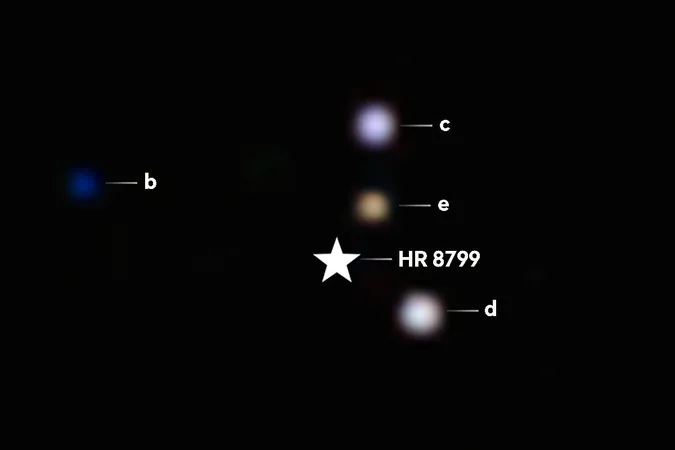
Stunning Discoveries: The James Webb Space Telescope Reveals Real Images of Exoplanets with Carbon-Rich Atmospheres!
2025-03-22
Author: Ming
James Webb Space Telescope's Revolutionary Discoveries
The James Webb Space Telescope (JWST) has taken a monumental leap forward in our understanding of distant worlds, capturing mesmerizing images of gas giant planets beyond our Solar System. These newly photographed planets, orbiting the star HR 8799, are located a mere 130 light-years away—a relatively close distance in the vast expanses of space.
The Young Star System HR 8799
HR 8799, previously known to host planets, is a young star system that dates back only about 30 million years. In contrast, our Solar System has been around for about 4.6 billion years. The planets in this system are still in their infancy, glowing brilliantly in the infrared spectrum—a specialty of the James Webb Space Telescope.
Rich Carbon Dioxide Atmospheres
What sets these newly observed exoplanets apart is their thick atmospheres rich in carbon dioxide. This discovery is crucial as it hints at the formation processes of these planets. According to astronomer William Balmer from Johns Hopkins University, "By spotting these strong carbon dioxide features, we have shown that there is a sizable fraction of heavier elements, like carbon, oxygen, and iron, in these planets’ atmospheres." This evidence suggests that like Jupiter and Saturn, these exoplanets likely formed through a process called core accretion: solid cores gradually attracting gas from the surrounding protoplanetary disc.
Understanding Our Solar System
In examining HR 8799, scientists are excited about the potential to comprehend the nature of our own Solar System in relation to others. "Our hope with this kind of research is to understand our own Solar System, life, and ourselves in comparison to other exoplanetary systems," Balmer explained. "This is a significant step in analyzing how unique or typical our Solar System might be."
Direct Imaging Advancements
Webb's impressive capabilities don't stop with HR 8799. It has also achieved noteworthy stages in the direct imaging of exoplanets—an area that has seen considerable advancements recently. In 2024, astronomers unveiled a direct image of Epsilon Indi Ab, a massive 'super Jupiter' located just 12 light-years away from Earth. Additionally, images of 51 Eridani b, yet another young exoplanet 96 light-years away, have offered further insights into the formation methods of celestial bodies.
Innovative Imaging Techniques
The pioneering images captured by Webb were made possible thanks to its cutting-edge NIRCam (Near-Infrared Camera) coronagraph, which cleverly blocks out the intense light from stars to reveal the fainter planets orbiting them. This technique is akin to shielding your eyes from sunlight to better observe your surroundings, allowing astronomers to gather critical data about the atmospheric compositions of these distant worlds.
Future Research and Discoveries
As researchers strive to enhance our knowledge of exoplanets, they remain committed to expanding upon these findings with future Webb observations. "We have other lines of evidence that hint at these four HR 8799 planets forming using a bottom-up approach," remarked Laurent Pueyo from the Space Telescope Science Institute. "The question now is: How common is this for planets we can directly image? We don’t know yet, but we are proposing further Webb observations to unlock those answers."
Conclusion
With each groundbreaking reveal, the James Webb Space Telescope is not only redefining our understanding of planets beyond our Solar System but is also preparing the path for myriad discoveries that will enrich our knowledge of the cosmos and our place within it. Stay tuned, as the universe has much more to show us!




 Brasil (PT)
Brasil (PT)
 Canada (EN)
Canada (EN)
 Chile (ES)
Chile (ES)
 Česko (CS)
Česko (CS)
 대한민국 (KO)
대한민국 (KO)
 España (ES)
España (ES)
 France (FR)
France (FR)
 Hong Kong (EN)
Hong Kong (EN)
 Italia (IT)
Italia (IT)
 日本 (JA)
日本 (JA)
 Magyarország (HU)
Magyarország (HU)
 Norge (NO)
Norge (NO)
 Polska (PL)
Polska (PL)
 Schweiz (DE)
Schweiz (DE)
 Singapore (EN)
Singapore (EN)
 Sverige (SV)
Sverige (SV)
 Suomi (FI)
Suomi (FI)
 Türkiye (TR)
Türkiye (TR)
 الإمارات العربية المتحدة (AR)
الإمارات العربية المتحدة (AR)